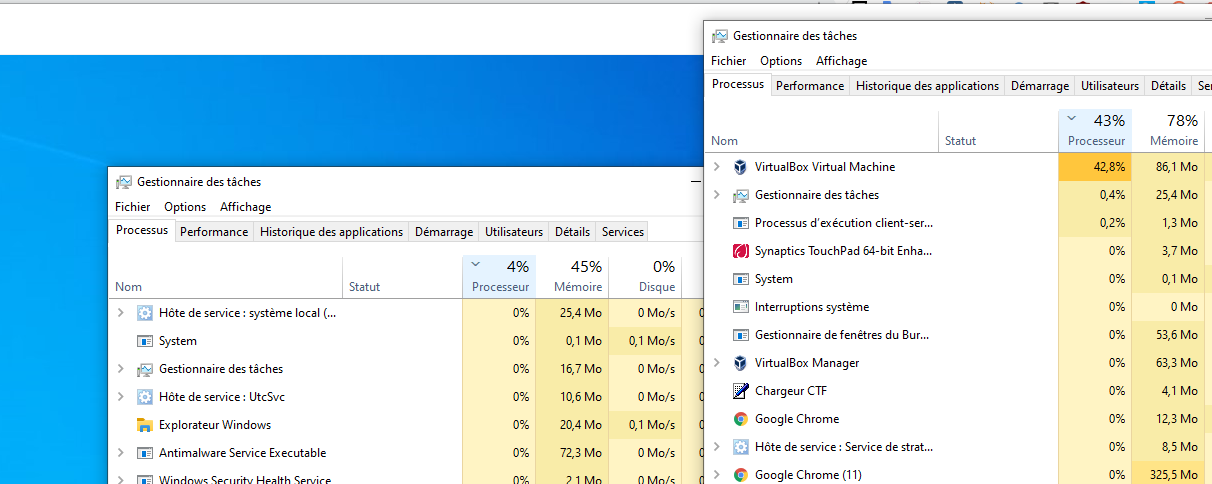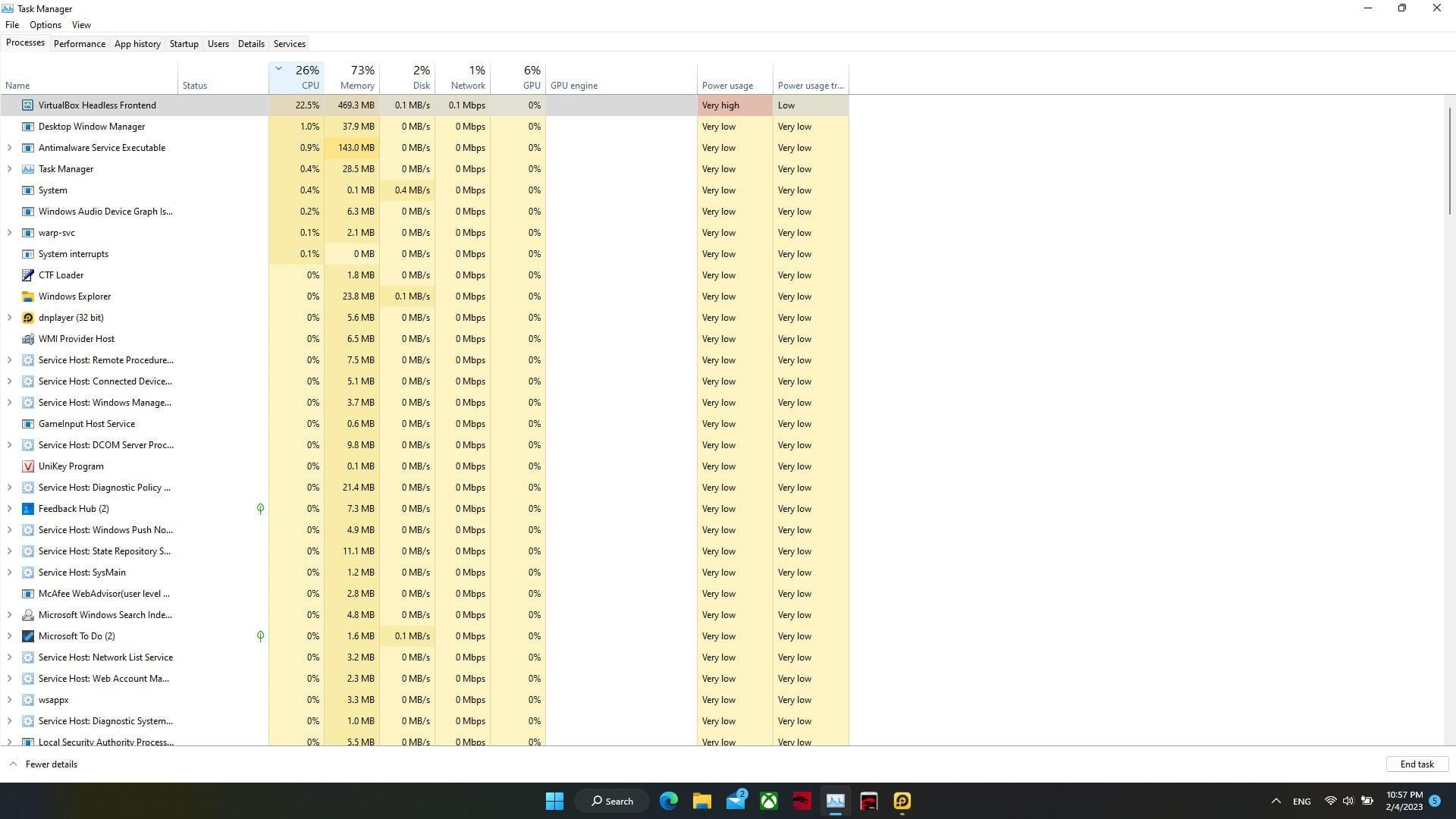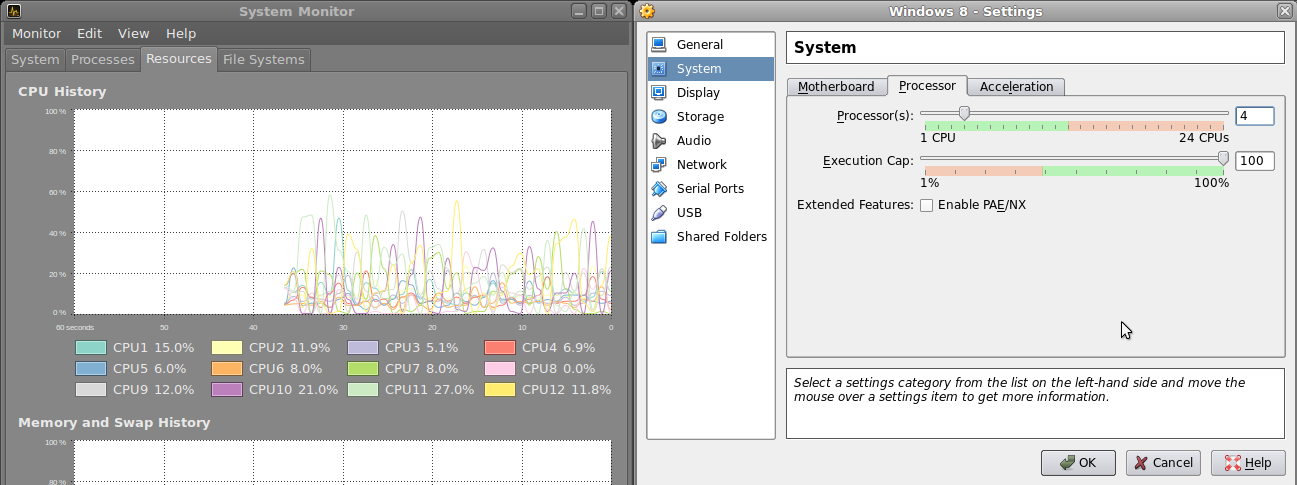- High power consumption is usually caused by the guest, configuration (vCPU/VRAM/execution), or host processes.
- Low VRAM and VRDP can spike CPU even without GUI; update VirtualBox and Guest Additions.
- Allocate vCPU within the recommended range and use Execution Cap to contain sustained spikes.
- Monitors both host and guest; extra memory doesn't lower CPU usage if the load is computational.

When a virtual machine VirtualBox If the host machine's CPU usage spikes, the experience becomes frustrating: fans are running at full blast, the system heats up, and everything seems to be stuttering. In many cases, even with the virtual machine idle, the VirtualBox process keeps the CPU level high for no apparent reason. Understanding what's going on underneath and how to tackle it is key to recovering performance..
This analysis brings together what works best according to the most repeated cases: from top snapshots in Linux with VBoxHeadless hovering around 95% CPU usage, to best practice recommendations on how much CPU to allocate, to common causes such as insufficient video memory or internal guest system tasks. You will find proven symptoms, causes and solutions, explained in Spanish and with a practical approach..
Symptoms and signs that the VM is hogging CPU

The first thing is to recognize the problem. On macOS, Activity Monitor may show the VM above 100% because that percentage is per logical core: if you assign 4 vCPUs, you'll see up to 400% as a ceiling. This doesn't always mean a failure, but it does indicate that the VM is maxing out the vCPUs..
En Windows’s most emblematic landmarks, the Task Manager on the host or guest may reveal a process hogging cycles. On Linux, top or htop often reveal a VBoxHeadless or VirtualBoxVM with abnormal usage. A typical pattern is to have the VM almost inactive and still observe sustained spikes.
A much-cited real-life case shows something like this on a Linux machine, with the VM having no graphical interface and booted in headless mode: A VBoxHeadless occupying 94% of CPU is a clear symptom
top - 19:12:xx up 25 min, 1 user, load average: 1.2, 1.3, 1.1
Tasks: 90 total, 2 running, 88 sleeping, 0 stopped, 0 zombie
Cpu(s): 10%us, 7%sy, 81%ni, 0%id, 0%wa, 1%hi, 1%si, 0%st
Mem: ~900M total, ~885M used, ~15M free, ~3M buffers
Swap: ~1G total, ~26M used, ~945M free, ~90M cached
PID USER PR NI VIRT RES SHR S %CPU %MEM TIME+ COMMAND
11491 user 20 0 416m 278m 6780 S 94.0 31.8 3:21 VBoxHeadless (vm A)
11536 user 20 0 295m 157m 6816 S 2.6 18.1 1:56 VBoxHeadless (vm B)
This type of reading fits with a single VirtualBox process tying up the CPU even when the guest should be idle. If you notice the fans going off and the equipment getting hot, you are seeing the same clinical picture..
Another curious but useful sign is to compare with other applications on the host: some people report VirtualBox with only 4–7% CPU and just over 100 MB of RAM on a Xubuntu 18.04 with a window open, while Firefox with a paused YouTube video takes up nearly 700 MB. This reminds you that CPU and memory usage do not always go hand in hand and that not all high resource usage is attributable to VirtualBox..
Why VirtualBox May Use Too Much CPU

The causes are usually grouped into three blocks: what the guest system does, how the VM is configured, and what happens on the host. Identifying which block the problem comes from saves you hours of trial and error..
Active or poorly optimized guest. If there are demanding processes or services within the VM, high usage is expected. Video or photo editing, CAD, gaming, indexing, or compilation are all resource-intensive by nature. Internal system tasks, such as updates or file indexing, also temporarily increase usage..
VirtualBox configurations that throttle or oversize. Allocating too many vCPUs can lead to more context switches and worse latency; conversely, leaving the VM without resources forces it to use what it has. There is also an unintuitive trigger: insufficient video memory or usage of VRDP which, even without a graphical interface in the guest, can cause rendering loops and spike the CPU.
Host running low on resources or experiencing interference. If the host computer is running low on CPU, the combination of VMs and host processes (browsers, synchronizers, antivirus, etc.) quickly saturates. In some reported cases, both VirtualBox like VMware They become slow with the same VMs, which points to the host as the culprit: drivers with issues, security services continuously scanning, background tasks, restrictive power plans or security mitigations that penalize certain hardware.
On macOS, also remember the per-core metric: seeing 200%, 300% or more in Activity Monitor can be normal if the VM has 2 or 3 vCPUs running at full capacity. The key data is not just that raw percentage, but if the team starts to slow down and symptoms of strangulation are perceived..
Practical solutions that really work

Increase the VM's video memory and reboot. This seemingly minor adjustment has resolved cases where VBoxHeadless would experience huge spikes, especially if you're using VRDP-type remote access or if any graphics components are involved. Increasing VRAM reduces unnecessary repaints and prevents CPU-hungry render loops even without a GUI..
Adjust your vCPUs wisely. VirtualBox displays a recommended range; staying within that range typically results in better latency. The power ceiling on the host will increase with each added vCPU; remember the 100% per-core math in system monitors. Not over-allocating is as important as not under-allocating..
Limit execution with the Execution Cap. In VM Configuration > System > Processor, you can set a CPU usage cap. This prevents the VM from monopolizing the host when you don't need maximum performance. It's an elegant way to contain spikes without touching processes inside the guest..
Update VirtualBox and Guest Additions. New versions bring performance improvements and compatibility fixes. The same applies to the guest kernel or system. A simple update can patch the exact bug that's eating away at your CPU..
Check the acceleration and paravirtualization. Switching between 3D, 2D, paravirtualization, or nested paging can make a difference depending on the guest. In some environments, disabling 3D eliminates loops; in others, enabling it offloads the GPU. Test changes one by one and measure their effect before settling on a configuration..
Monitor guest processes. Open Task Manager in Windows or Top in Linux inside the VM and locate the greedy process. If it's a system process, it could be related to updates, search indexes, or drivers. If it's an application, check its documentation: there are softwares where high CPU usage is the normal state in certain tasks..
Lighten your host. Close background processes, pause syncs, and exclude VM folders from antivirus if it's safe to do so. Prevent a browser with many tabs from competing with your VM for the same resources. The performance of the VM will never be better than that of the host that hosts it..
Pay attention to power and cooling. A restrictive power plan or a CPU that runs hot and underclocks can become a bottleneck. Switch to High Performance and make sure there's no thermal throttling. A CPU dropping in frequency explains why everything is jerky..
Typical cases: Very slow VM on multiple hypervisors. If both VirtualBox and VMware suffer from the same VMs (e.g. Windows XP on a Windows 10 laptop), it points to the host: security services scanning disks, problematic drivers or system tasks. When the problem is reproduced on different hypervisors, it is almost always outside the VM..
Step-by-step diagnosis and frequently asked questions
Separating the source of consumption allows you to get straight to the point. Start with the guest: Are processes overloaded? Has it just started up after months of downtime and is undergoing maintenance? Then look at the host: What else is consuming? Are there updates, indexers, or heavy services running? Only then fine-tune the VM settings: vCPU, VRAM, acceleration, maximum execution.
Why might a VM in headless mode use so much CPU? Because the guest is busy, the workload is intensive, or the host can't keep up with the demand. Loops may also occur due to VRDP or undersized graphics resources..
How do I diagnose it judiciously? Monitor both internally and externally: Task Manager on the guest, Top or System Monitor on the host. In VirtualBox, you can rely on the Command line (CLI) to obtain metrics and also in VirtualBox Manager itself or third-party utilities. Look for correlations: when a process in the guest goes up, does the VirtualBox process on the host go up?
Do I optimize by allocating more memory? Increasing the VM's RAM improves many things, but it doesn't directly reduce the CPU usage if the load is computational. Memory and CPU are related, but they are different bottlenecks; RAM doesn't fix a process that, by design, does a lot of calculations..
Should I assign all available vCPUs? No. It's best to use the number recommended by the tool and your hardware. By allocating more vCPUs, the guest system benefits from parallelizable loads, but it increases contention. Assigning more than recommended can worsen the overall performance of the team..
What do I do if the guest is quiet, but the host is still running on CPU? Then, focus on the settings and environment: increase VRAM, adjust acceleration, limit execution, update VirtualBox and Guest Additions, and check host processes. Minor configuration changes have resolved cases where VBoxHeadless would spin for no apparent reason..
Is it normal to see 200%, 300%, or more on macOS? Yes, because that percentage is per logical core. With 4 vCPUs, a VM can reach 400% total utilization in Activity Monitor. The important thing is whether this sustained use degrades the rest of the system or if it responds to a specific, expected task..
What settings should I adjust first in VirtualBox? I'd start with VRAM, vCPU count, and Execution Cap; then 3D/2D acceleration and paravirtualization. Always one by one and measuring. Upgrading to the latest stable version of VirtualBox is usually a low-risk, high-return step..
Tip for a Windows guest that's running slow after a period of inactivity: Let it complete its internal tasks (updates, indexing). If it persists, identify the process and seek documentation from the software manufacturer. Many spikes are temporary and it is best not to blindly kill system processes..
One final, very practical note: if you're using remote access to the VM or desktop rendering, make sure to allocate enough VRAM, and if you don't need graphics, minimize graphics services in the guest. A simple adjustment like video memory has been the solution in more than one case of irrational consumption..
When you put all this together, the common thread becomes clear: high CPU usage is almost always explained by a mix of actual guest load, configuration improvements, and interfering host processes. With the above checks and a few measured tweaks, it is perfectly possible to tame VirtualBox and regain smooth performance without sacrificing production and stability.
Passionate writer about the world of bytes and technology in general. I love sharing my knowledge through writing, and that's what I'll do on this blog, show you all the most interesting things about gadgets, software, hardware, tech trends, and more. My goal is to help you navigate the digital world in a simple and entertaining way.
